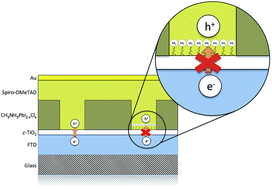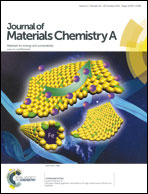Performance enhancement of solution processed perovskite solar cells incorporating functionalized silica nanoparticles†
Abstract
High efficiency, solution processed organic–inorganic trihalide perovskite solar cells are now a reality, meaning that perovskite photovoltaics have the potential to challenge more established photovoltaic technologies. To date, some of the most efficient solution processed perovskite solar cells feature a pre-deposited Al2O3 scaffold and we have shown in a previous communication, that it is possible to make efficient devices by co-depositing the Al2O3 nanoparticles with the perovskite precursor solution. In this work, we have substituted the alumina nanoparticles with 3-aminopropyl (3-oxobutanoic acid) functionalized silica nanoparticles (f-SiO2). We observe performance enhancements in planar heterojunction (PHJ) devices made with up to 0.75 wt% f-SiO2 nanoparticles present in the precursor solution, yielding power conversion efficiencies (PCE) of up to 12.4%, compared to the maximum PCE of 10.5% in the equivalent PHJ devices made without f-SiO2 nanoparticles. The performance enhancement arises in part from an average increase to VOC by up to 50 mV when the nanoparticles are present in the precursor solution and is attributed to substrate passivation within pinholes formed in the perovskite film during processing.


 Please wait while we load your content...
Please wait while we load your content...